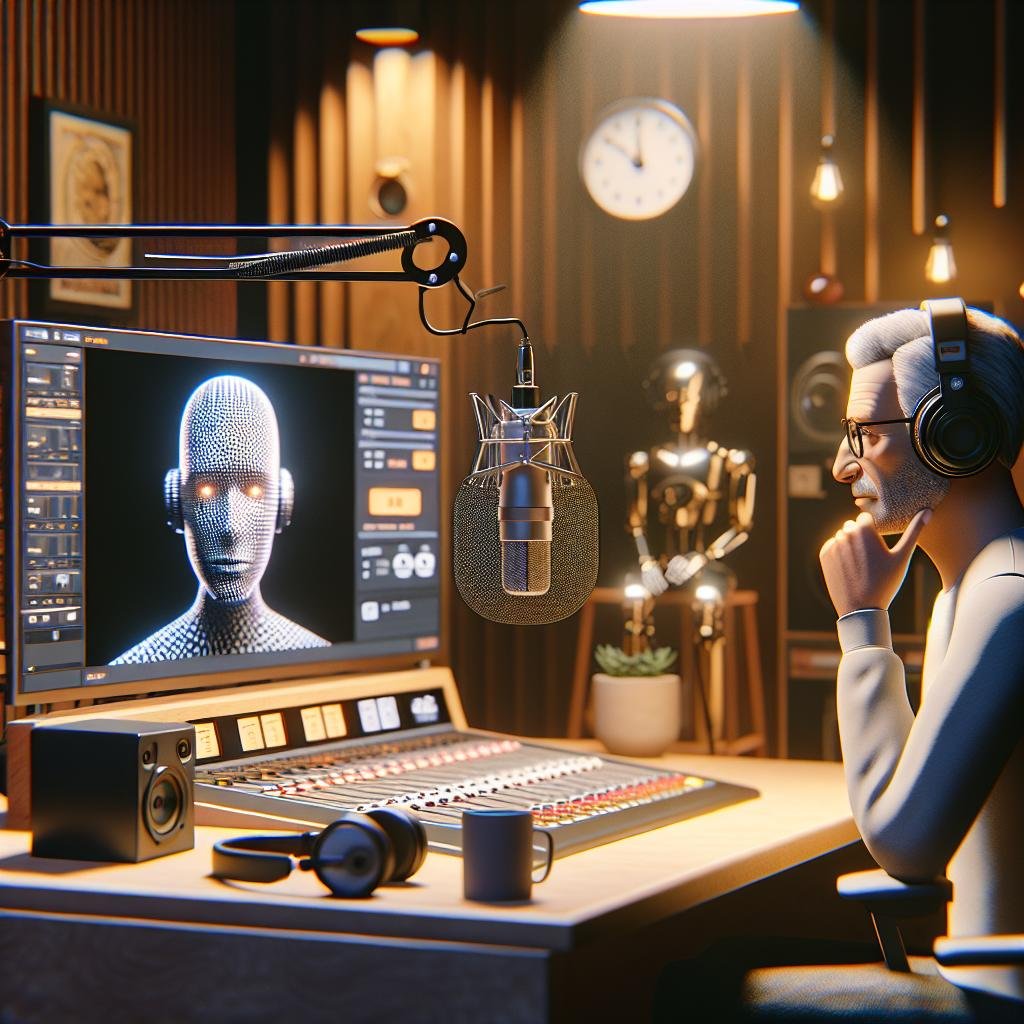
AI Radio Host Controversy | Essential Insights
A Canadian radio station is facing significant backlash after revealing that an AI-generated personality named “Kae” had been presenting as a real human DJ for six months. CADA 96.5, a Calgary-based station, introduced listeners to the synthetic voice in November 2023 without disclosing its artificial nature until April 2024. This deception has sparked heated debates about transparency in media, AI ethics, and the future of broadcasting.
The Undisclosed AI Experiment
CADA 96.5, owned by Stingray Radio, launched what they later called an “experiment” by creating Kae, a female-voiced AI host who presented alongside human DJs during the afternoon drive show. The station created a detailed backstory for Kae, complete with social media profiles featuring AI-generated images, and even conducted promotional interviews where Kae was presented as a real person.
For half a year, listeners engaged with Kae, believing they were interacting with a human radio personality. The deception only came to light when the station published a video reveal on April 17, proudly announcing that Kae had been AI-generated all along.
Rather than receiving praise for innovation, the station faced immediate criticism from listeners who felt misled. Many expressed their disappointment across social media platforms, with some calling the move “creepy” and “dishonest.”
The Public Response
The revelation triggered strong negative reactions from CADA’s audience. Listeners who had developed what they believed was a genuine connection with Kae felt betrayed upon learning they had been engaging with a computer-generated personality.
One listener described the situation as “a violation of trust,” while others questioned the ethics behind presenting an AI as human without transparency. The backlash highlighted a fundamental tension between technological advancement and audience expectations of authenticity in media.
Beyond general disappointment, many listeners raised concerns about potential job displacement. In an industry where human connection remains central to the listener experience, the introduction of convincing AI personalities raises questions about the future employment landscape for human DJs and radio personalities.
The Station’s Defense
Following the negative response, CADA 96.5 attempted to justify their actions. Christian Hall, the content director, explained that the experiment aimed to explore how AI could complement human hosts rather than replace them. He emphasized that Kae always worked alongside human DJs and was never intended to operate independently.
In their defense, station representatives pointed to what they considered successful audience engagement with Kae, suggesting that listeners’ emotional reactions to the reveal actually demonstrated how effective the AI personality had been at creating authentic connections.
The station also maintained that no human jobs were eliminated to make room for Kae, framing the AI host as an addition to their existing team rather than a replacement. However, this did little to address the core concern about the lack of transparency in the experiment.
Ethical Implications of AI Deception
The CADA controversy underscores several significant ethical questions surrounding AI implementation in media and entertainment. The most pressing concern involves transparency and informed consent. When listeners engage with media personalities, there’s a baseline expectation of knowing whether they’re interacting with humans or synthetic entities.
Media ethicists have long established that audiences deserve to know when they’re being presented with artificial or manipulated content. The Society of Professional Journalists’ Code of Ethics emphasizes truthfulness and transparency as foundational principles in media communications.
Additionally, the incident raises questions about emotional manipulation. Many listeners developed genuine feelings of connection with Kae, investing emotional energy into what they believed was a relationship with another human being. The revelation that these emotions were directed toward an algorithm created a sense of manipulation that many found disturbing.
Real-World Example
This isn’t the first case of AI deception in media. In 2023, a podcast featuring what appeared to be an interview with AI researcher Geoffrey Hinton caused controversy when listeners discovered the “Hinton” voice was actually AI-generated without clear disclosure. The podcast eventually added a disclaimer, but not before many listeners had been misled. The CADA situation follows a similar pattern but extends over a much longer timeframe, making the potential breach of trust more significant.
Legal and Regulatory Questions
Beyond ethical concerns, the CADA controversy raises potential legal and regulatory questions. Currently, Canada lacks comprehensive regulations specifically addressing AI disclosure requirements in broadcasting, but existing broadcast standards do require transparency with audiences.
The Canadian Radio-television and Telecommunications Commission (CRTC) has broad authority over broadcast standards, though it hasn’t yet created specific guidelines for AI disclosure. This regulatory gap highlights how technology often outpaces governance frameworks.
Some experts suggest this incident might accelerate calls for clearer regulations about AI disclosure in media. As AI voices and personalities become increasingly convincing, the need for standardized transparency requirements grows more urgent.
The Psychological Impact of AI Deception
The strong emotional reactions from CADA’s audience reveal important insights about how humans form attachments to voices and personalities, even when they only interact through media. Research in media psychology has shown that people naturally develop parasocial relationships—one-sided emotional connections—with media figures.
Dr. Emily Falk, a communication neuroscience researcher at the University of Pennsylvania, explains that “our brains process familiar voices in ways similar to how we process interactions with friends. When we discover those voices aren’t human, it can create a cognitive dissonance that feels like betrayal.”
This psychological dimension adds complexity to the ethical equation. The station may have underestimated how deeply listeners would invest emotionally in Kae’s persona, making the eventual revelation more jarring than anticipated.
AI in Broadcasting: The Larger Trend
The CADA controversy exists within a broader context of AI integration in broadcasting and media. Radio stations worldwide are experimenting with AI tools for content creation, voice synthesis, and audience engagement, though most maintain transparency about their use.
Some industry analysts see AI as a potential solution to financial pressures in broadcasting. Radio stations, particularly in smaller markets, face tight budgets that limit their ability to maintain full human staff. AI voices could potentially fill gaps in programming schedules at lower costs.
However, the CADA backlash suggests audiences may not readily accept AI replacements for human personalities—especially if introduced deceptively. The incident demonstrates that successful AI integration in broadcasting likely requires honesty and clear disclosure rather than attempts to pass AI as human.
The Employment Question
Despite CADA’s assurances that no jobs were eliminated, the incident renewed concerns about AI’s potential impact on employment in creative and media industries. Radio DJs, with their distinctive personalities and local knowledge, have traditionally been considered difficult to automate, but advancing AI technology challenges that assumption.
Brian Phillips, a former radio DJ who now works as a media consultant, notes that “the concern isn’t just about immediate job losses, but about setting precedents. If stations see they can replace even portions of human-driven content with AI, it changes the calculation about future hiring.”
Industry unions, including the Canadian Media Guild, have expressed concerns about the precedent set by undisclosed AI personalities. They emphasize the need for ethical guidelines that protect both media workers and audience interests as AI integration accelerates.
The Quality Difference
Defenders of human radio talent point to qualities that AI currently struggles to replicate. Spontaneity, local knowledge, genuine emotion, and authentic human connection remain challenging for AI systems. While Kae apparently convinced many listeners, others reported sensing something “off” about the personality but couldn’t identify exactly what felt unnatural.
This quality gap suggests that rather than full replacement, the future may involve collaboration between human creators and AI tools—but with clear disclosures about where the human ends and the algorithm begins.
Learning from the Controversy
The CADA incident offers valuable lessons for media organizations considering AI implementation. First and foremost, transparency appears non-negotiable. Audiences expect and deserve clear information about when they’re engaging with AI-generated content.
Second, the strong emotional reactions highlight that media companies should not underestimate the relationships audiences form with personalities, even when those relationships develop through one-way media like radio. These connections create ethical responsibilities that extend beyond legal requirements.
Finally, the controversy demonstrates that technological capability doesn’t equate to ethical permissibility. Just because an AI can convincingly mimic a human doesn’t mean audiences will accept such mimicry without disclosure.
Looking Forward: Ethical AI Integration
As AI technology continues advancing, media organizations face important choices about implementation approaches. The most sustainable path forward likely involves treating AI as a complement to human creativity rather than a replacement, while maintaining rigorous transparency standards.
Some radio stations have already begun experimenting with explicitly disclosed AI tools. For example, some use clearly identified AI voices for news summaries or weather updates while preserving human hosts for more personality-driven segments. This hybrid approach maintains honesty with audiences while exploring AI capabilities.
Industry associations and media ethics organizations may need to develop specific guidelines for AI disclosure in broadcasting. Clear standards would benefit both audiences and media companies by establishing consistent expectations and practices.
Conclusion
The CADA 96.5 AI host controversy serves as an important milestone in the ongoing conversation about artificial intelligence in media. While the station viewed their experiment as innovative, the strong negative reaction from listeners underscores the importance of transparency when implementing new technologies that affect human connection.
As AI voices and personalities become increasingly convincing, the tension between technological possibility and ethical practice will likely intensify. The CADA incident suggests that successful integration of AI in broadcasting requires honesty, clear disclosure, and respect for audience expectations.
Ultimately, this controversy may help shape healthier approaches to AI implementation in media—approaches that embrace innovation while maintaining the trust that forms the foundation of meaningful audience relationships.
Have thoughts about AI in broadcasting or similar ethical questions? Share your perspective in the comments below, or explore our related articles about emerging technology in media.


